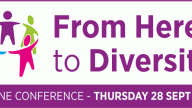EEDI (Equality, Equity, Diversity and Inclusivity) and Wellbeing Hub
5 ways to help your team bring their lived experience to work
The team from The McPin Foundation have provided some fantastic tips on how charity leaders and managers can encourage staff to bring their whole selves to work.
Imagine bringing your whole self to work, without fear of stigma, knowing your lived experiences are an asset and not a deficit; they are embraced and increase the positive impact of your organisation.
At its simplest, lived experience is knowledge gained through everyday living – usually related to a challenging or difficult experience – rather than something you have studied for or learned on the job.
Lived experience expertise can sit alongside academic or occupational expertise and will intersect with other identities.
As a mental health research charity, McPin tries to build an environment where our team can work in this way. We believe that bringing our lived experience of mental health issues to our work improves the quality of the research we do.
Employers should strive to ensure everyone can bring their lived experience to work, if an individual chooses to, in a safe and manageable way. Here are five ways we’re working on making that possible at McPin.
1. Understanding disclosure
Or ‘what, when and how to share your lived experience’. At McPin, no one is obligated to share anything they don’t feel comfortable, supported and safe to. We work with our team so everyone understands the implications, as well as potential benefits, of disclosing personal and potentially re-traumatising information.
2. What lived experience can bring to the workplace
Working in this way can bring deeper connections. This may be primarily for participants in research studies but could also include other staff working on a project, or members of the public who are interested in hearing about our work.
We have found being conscious of lived experience has improved communication with each other, and the people we engage with. Our team felt lived experience helps them speak authentically to others with lived experience and to be sensitive to language and ideas that, although commonly used, might be upsetting for people.
3. Developing the skills to manage lived experience working
Employers wanting to build their lived experience workforce should embed regular training opportunities.
Having lived experience of an issue, and drawing on it safely and confidently at work, are two very different things. Some people innately have those skills; some don’t, but they can be developed with support and training.
Self-awareness, boundary setting, managing disclosure, reflection and respect of others are all important to lived-experience work.
4. Be aware of the obstacles
At McPin, we believe that working from a lived experience perspective is rewarding and beneficial but there are obstacles.
Stigma, discrimination, imposterism and emotional cost are some of the challenges people might face while using their lived experience at work.
5. Practical supports to help understand and overcome obstacles
We create spaces for conversation and reflection. We run reflective practice sessions where we can share scenarios and difficulties and either crowd-source solutions or just feel bolstered by working through our thoughts alongside others.
Our team is offered access to external mentors, designed to allow people to have confidential conversations with someone who is not directly involved in their work about things they may be struggling with.
Being flexible about time given for self-care and providing considered training options are other practical supports we use.
Ultimately, we view people holistically. The people we employ have a broad range of skills and talents, and to reduce their contributions to the single dimension of lived experience can be demoralising.
Lived experience pays dividends
Putting lived experience at the heart of our mental health research works for McPin. Creating an environment where your teams feel able to bring their lived experience to work can pay dividends for other organisations too.
As one of our team said: “part of using lived experience is being able to ask difficult questions, but to do that in a sensitive and compassionate way. It’s about gently challenging others’ mindset and building bridges.”
If you’d like to read more about using lived experience in the workplace, including our tips on disclosure, check out our new resource: 10 for 10: Using lived experience in the workplace | The McPin Foundation


